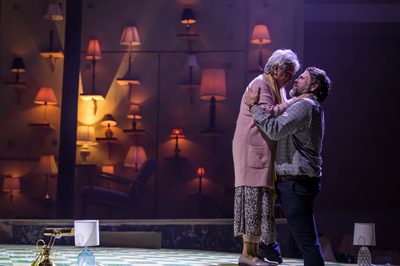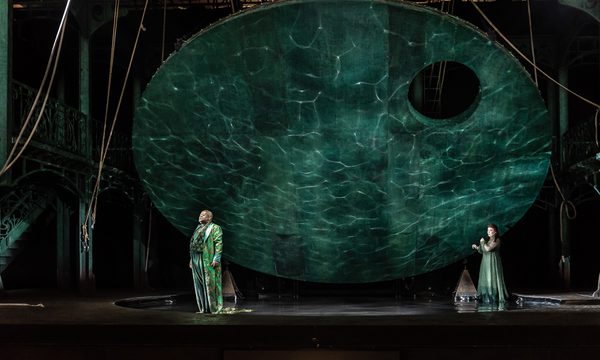
News Story
This summer, lose yourself in magical worlds filled with gods, monsters, heroes and villains with a Festival programme sprinkled with works inspired by folklore from around the world. Our line-up this August includes dance that reimagines pagan Slavic rituals, theatre that tells the story of Greek gods and mortals, classical music inspired by a chivalric Celtic legend and opera that reinvents a chilling fairy tale as a bittersweet love story.
Trojan Women
I felt there was a lot of synergy between Greek theatre and Korean traditional forms. Greek theatre is epic, the emotions and passions are huge – they are not daily life emotions.
Starting in the world of Ancient Greece, we meet the Trojan women in Ong Keng Sen’s compelling new production of this centuries-old tale. Originally written by Euripides and first performed in 415BC, the story begins at the very end of the Trojan War, after almost all the male heroes of the story – Achilles, Ajax, Hector and Paris – have killed each other in battle and Troy has been captured by the Greeks. The play follows what happens to the women who have survived this carnage, including Helen of Troy herself as well as Hector’s mother Hecuba, widow Andromache and sister Cassandra.
Unfortunately, since this is a Greek tragedy, there’s yet more carnage in store. A herald enters to tell each of the women their fates. Each will become a slave or concubine to one of the invading army’s leaders, while their children are murdered to avoid the possibility of them growing up to avenge their parents. The husband Helen abandoned in Troy, Menelaus, tells her that she will be taken back to Greece to be executed, but Helen has other ideas, persuading him to take her back as his wife instead.
In Ong Keng Sen’s version with the National Changgeuk Company of Korea, the narrative is told through the Korean operatic form of changgeuk and takes on resonances well beyond the original context – most notably evoking the experience of Korean ‘comfort women’ enslaved by the Japanese army in the Second World War.
Trojan Women is at the Festival Theatre from Wednesday 9 – Friday 11 August.
Ogresse
Multi-Grammy Award-winning artist Cécile McLorin Salvant makes her first appearance at the International Festival this summer, performing both a solo concert and the UK premiere of her own song cycle, Ogresse, a musical journey of myth and song.
The narrative, told through 17 songs, draws from a wide range of different folkloric traditions, storytelling influences and historical events. Speaking to the SF Jazz magazine, Salvant references musical and literary influences including The Little Mermaid’s villainous sea witch Ursula; a painting of the Voudou goddess of love and femininity, Erzulie Fréda Dahomey; and the true story of Sarah Baartman, a South African woman who was taken to Europe to be exhibited in ‘freak shows’ in the early 19th century. These combine for an exploration of femininity, monstrosity, race and identity.
Ogresse is at the Festival Theatre on Saturday 5 August.
The Rite of Spring
I saw in imagination a solemn pagan rite; sage-elders, seated in a circle, watching a young girl dance herself to death. They were sacrificing her to propitiate the god of Spring.
The premiere of The Rite of Spring caused possibly one of the biggest storms in theatrical history due to the groundbreaking modernity of its movement and music, however, its narrative is actually partially based on ancient pagan Slavic traditions. Composer Igor Stravinsky worked closely with Nikolai Roerich, an archaeologist and folklorist with an interest in historical rites, to create the story. Subtitled ‘Picture of Pagan Russia’, the ballet was based on an original idea by Stravinsky then embellished by Roerich, who drew inspiration from his research into pagan rituals around the changing of the seasons and worshipping the sun.
In Roerich’s vision of these mystical traditions, a young girl is chosen as a sacrifice and must dance to death, watched by a circle of elders dressed in bear skins – although there’s little surviving evidence to suggest this was a genuine historical practice. Roerich also designed the costumes, drawing on his knowledge of traditional clothing in rural Russia.
In 1978, over 60 years after that scandalous premiere, Pina Bausch presented her own take on the tale for the first time in the UK at the Edinburgh International Festival. Leaving Roerich’s embroidered peasant costumes far behind, Bausch’s choreography plays out against a stark, soil-covered stage and powerfully reveals the misogyny within the superstitions driving the ritual. It’s performed at this year’s International Festival by a cast of 34 specially assembled dancers from 14 African countries.
The Rite of Spring / common ground[s] is at the Edinburgh Playhouse from Thursday 17 – Saturday 19 August.
Phaedra / Minotaur
This double bill of cantata and ballet, conceived by acclaimed director Deborah Warner, explores what happens when you fall foul of the Ancient Greek gods. Over the course of the evening, we meet first Phaedra, then the Minotaur – mythological half-siblings, both doomed to tragic fates.
According to legend, after King Minos of Crete offended Poseidon the god retaliated by making his wife, Queen Pasiphaë, fall in love with a bull. It’s unclear why Pasiphaë got the short straw here, but the liaison resulted in her giving birth to the Minotaur – half-man, half-bull, with a cannibalistic diet that condemns him to imprisonment in a labyrinth. Years later, King Minos wins a war between the two kingdoms and demands that Athens now send seven young men and seven young women to Crete as sacrifices, to be devoured by the Minotaur.
Eventually Theseus, Prince of Athens, volunteers to enter the labyrinth. He successfully slays the Minotaur, ending the bloodshed – but don’t root for him too much. He’s helped in this endeavour by Minos’s daughter Ariadne, who’s fallen madly in love with Theseus and will do anything to save him, as long as he takes her with him when he leaves. He does... then changes his mind and leaves her on a deserted island, running off with her younger sister, Phaedra, instead.
Based on what happens next, it’s unclear how enthusiastic Phaedra ever was about this plan. When we meet her in Benjamin Britten’s cantata, she’s married to Theseus, but all she can think about is her desire for his son, Hippolytus. Tormented by guilt, she prepares to take her own life. The moving cantata follows her thoughts and feelings as she speaks to herself, her stepson, her confidant and, lastly, her husband.
Phaedra / Minotaur is at The Lyceum from Friday 18 – Sunday 20 August.
Bluebeard’s Castle
Bluebeard and his wife make their first written appearance in Charles Perrault’s 1697 collection of fairy tales and have since influenced classic works of fiction including Jane Eyre, Rebecca and The Bloody Chamber. Bluebeard brings his new bride to his castle and shows her a mysterious locked door, which she is forbidden to open. Her curiosity overcomes her and she opens the door, only to find the bodies of Bluebeard’s six previous wives, each murdered by him. When Bluebeard realises she has discovered his secret he goes to kill her too, but fortunately, her brothers arrive in time to save her. Perrault’s moral of the story, interestingly, has nothing to say about the ethics of serial murder, only that:
“Curiosity, in spite of its appeal, often leads to deep regret. To the displeasure of many a maiden, its enjoyment is short lived. Once satisfied, it ceases to exist, and always costs dearly.”
In the early 19th century, the Hungarian composer Béla Bartók took the story as inspiration for his only opera. In his take, Bluebeard’s new wife, named Judith, professes her love for him, despite the unsettling rumours she has heard. She pleads with him to open the seven locked doors in his castle, while he insists that her love should mean asking him no questions. Judith persuades him to show her each locked room in turn, eventually uncovering his three other wives behind the last door – still seemingly alive, but ghostly and silent, waiting for her to join them.
For director Daisy Evans, the darkness of the libretto has always been at odds with the score: “the music is just too beautiful... it’s about love and loss and emotion”. In her modern retelling, the tale becomes a true love story, as each of Bluebeard’s locked-away wives is a memory of Judith’s past self that the present-day woman, living with dementia, no longer recognises.

Bluebeard’s Castle is at Church Hill Theatre from Wednesday 23 – Sunday 27 August.
Tristan und Isolde (The Closing Concert)
Often compared to Romeo and Juliet, the story of these star-crossed lovers may date back even earlier. The details depend on the time and the teller, but the tragic fate remains the same. Tristan is sent to Ireland to bring back the beautiful Isolde to be the bride of his beloved uncle, King Mark of Cornwall. Instead, they fall hopelessly in love with each other, but, bound by duty, Isolde must still marry the King. Although they try to continue meeting in secret, ultimately, their affair cannot continue. After their separation Tristan is wounded and sends for Isolde as the only person who can cure him but dies in her arms.
Richard Wagner used the story as the basis for his soaring three-act opera, which premiered in 1865 after a tumultuous journey to the stage. At this year’s International Festival closing concert, Karina Canellakis conducts the BBC Scottish Symphony Orchestra, Edinburgh Festival Chorus and three outstanding soloists in the opera’s prelude and concluding Liebestod, literally translated as ‘love-death’.
The Closing Concert is at the Usher Hall on Sunday 27 August.
Which of these mythological masterpieces are you most intrigued by? Let us know what you've snapped up tickets for by getting in touch on social media using #EdIntFest.



